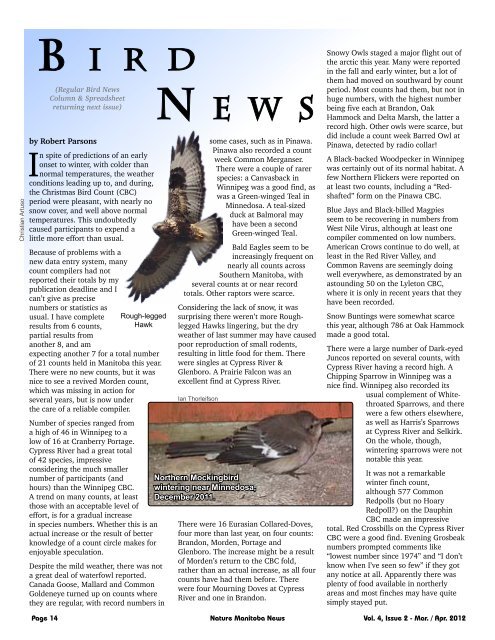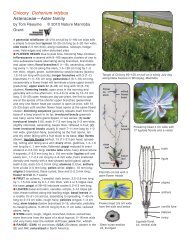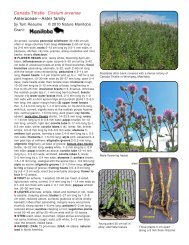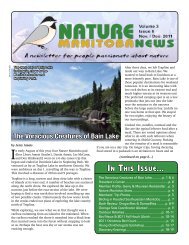View/Download Newsletter (.pdf, 5.21 MB) - Nature Manitoba
View/Download Newsletter (.pdf, 5.21 MB) - Nature Manitoba
View/Download Newsletter (.pdf, 5.21 MB) - Nature Manitoba
You also want an ePaper? Increase the reach of your titles
YUMPU automatically turns print PDFs into web optimized ePapers that Google loves.
Christian Artuso<br />
(Regular Bird News<br />
Column & Spreadsheet<br />
returning next issue)<br />
by Robert Parsons<br />
In spite of predictions of an early<br />
onset to winter, with colder than<br />
normal temperatures, the weather<br />
conditions leading up to, and during,<br />
the Christmas Bird Count (CBC)<br />
period were pleasant, with nearly no<br />
snow cover, and well above normal<br />
temperatures. This undoubtedly<br />
caused participants to expend a<br />
little more effort than usual.<br />
Because of problems with a<br />
new data entry system, many<br />
count compilers had not<br />
reported their totals by my<br />
publication deadline and I<br />
can’t give as precise<br />
numbers or statistics as<br />
usual. I have complete<br />
results from 6 counts,<br />
partial results from<br />
another 8, and am<br />
Rough-legged<br />
Hawk<br />
expecting another 7 for a total number<br />
of 21 counts held in <strong>Manitoba</strong> this year.<br />
There were no new counts, but it was<br />
nice to see a revived Morden count,<br />
which was missing in action for<br />
several years, but is now under<br />
the care of a reliable compiler.<br />
Number of species ranged from<br />
a high of 46 in Winnipeg to a<br />
low of 16 at Cranberry Portage.<br />
Cypress River had a great total<br />
of 42 species, impressive<br />
considering the much smaller<br />
number of participants (and<br />
hours) than the Winnipeg CBC.<br />
A trend on many counts, at least<br />
those with an acceptable level of<br />
effort, is for a gradual increase<br />
in species numbers. Whether this is an<br />
actual increase or the result of better<br />
knowledge of a count circle makes for<br />
enjoyable speculation.<br />
Despite the mild weather, there was not<br />
a great deal of waterfowl reported.<br />
Canada Goose, Mallard and Common<br />
Goldeneye turned up on counts where<br />
they are regular, with record numbers in<br />
some cases, such as in Pinawa.<br />
Pinawa also recorded a count<br />
week Common Merganser.<br />
There were a couple of rarer<br />
species: a Canvasback in<br />
Winnipeg was a good find, as<br />
was a Green-winged Teal in<br />
Minnedosa. A teal-sized<br />
duck at Balmoral may<br />
have been a second<br />
Green-winged Teal.<br />
Bald Eagles seem to be<br />
increasingly frequent on<br />
nearly all counts across<br />
Southern <strong>Manitoba</strong>, with<br />
several counts at or near record<br />
totals. Other raptors were scarce.<br />
Considering the lack of snow, it was<br />
surprising there weren’t more Roughlegged<br />
Hawks lingering, but the dry<br />
weather of last summer may have caused<br />
poor reproduction of small rodents,<br />
resulting in little food for them. There<br />
were singles at Cypress River &<br />
Glenboro. A Prairie Falcon was an<br />
excellent find at Cypress River.<br />
Ian Thorleifson<br />
Northern Mockingbird<br />
wintering near Minnedosa,<br />
December 2011.<br />
There were 16 Eurasian Collared-Doves,<br />
four more than last year, on four counts:<br />
Brandon, Morden, Portage and<br />
Glenboro. The increase might be a result<br />
of Morden’s return to the CBC fold,<br />
rather than an actual increase, as all four<br />
counts have had them before. There<br />
were four Mourning Doves at Cypress<br />
River and one in Brandon.<br />
Snowy Owls staged a major flight out of<br />
the arctic this year. Many were reported<br />
in the fall and early winter, but a lot of<br />
them had moved on southward by count<br />
period. Most counts had them, but not in<br />
huge numbers, with the highest number<br />
being five each at Brandon, Oak<br />
Hammock and Delta Marsh, the latter a<br />
record high. Other owls were scarce, but<br />
did include a count week Barred Owl at<br />
Pinawa, detected by radio collar!<br />
A Black-backed Woodpecker in Winnipeg<br />
was certainly out of its normal habitat. A<br />
few Northern Flickers were reported on<br />
at least two counts, including a “Redshafted”<br />
form on the Pinawa CBC.<br />
Blue Jays and Black-billed Magpies<br />
seem to be recovering in numbers from<br />
West Nile Virus, although at least one<br />
compiler commented on low numbers.<br />
American Crows continue to do well, at<br />
least in the Red River Valley, and<br />
Common Ravens are seemingly doing<br />
well everywhere, as demonstrated by an<br />
astounding 50 on the Lyleton CBC,<br />
where it is only in recent years that they<br />
have been recorded.<br />
Snow Buntings were somewhat scarce<br />
this year, although 786 at Oak Hammock<br />
made a good total.<br />
There were a large number of Dark-eyed<br />
Juncos reported on several counts, with<br />
Cypress River having a record high. A<br />
Chipping Sparrow in Winnipeg was a<br />
nice find. Winnipeg also recorded its<br />
usual complement of Whitethroated<br />
Sparrows, and there<br />
were a few others elsewhere,<br />
as well as Harris’s Sparrows<br />
at Cypress River and Selkirk.<br />
On the whole, though,<br />
wintering sparrows were not<br />
notable this year.<br />
It was not a remarkable<br />
winter finch count,<br />
although 577 Common<br />
Redpolls (but no Hoary<br />
Redpoll?) on the Dauphin<br />
CBC made an impressive<br />
total. Red Crossbills on the Cypress River<br />
CBC were a good find. Evening Grosbeak<br />
numbers prompted comments like<br />
“lowest number since 1974” and “I don’t<br />
know when I’ve seen so few” if they got<br />
any notice at all. Apparently there was<br />
plenty of food available in northerly<br />
areas and most finches may have quite<br />
simply stayed put.<br />
Page 14 <strong>Nature</strong> <strong>Manitoba</strong> News Vol. 4, Issue 2 - Mar. / Apr. 2012





